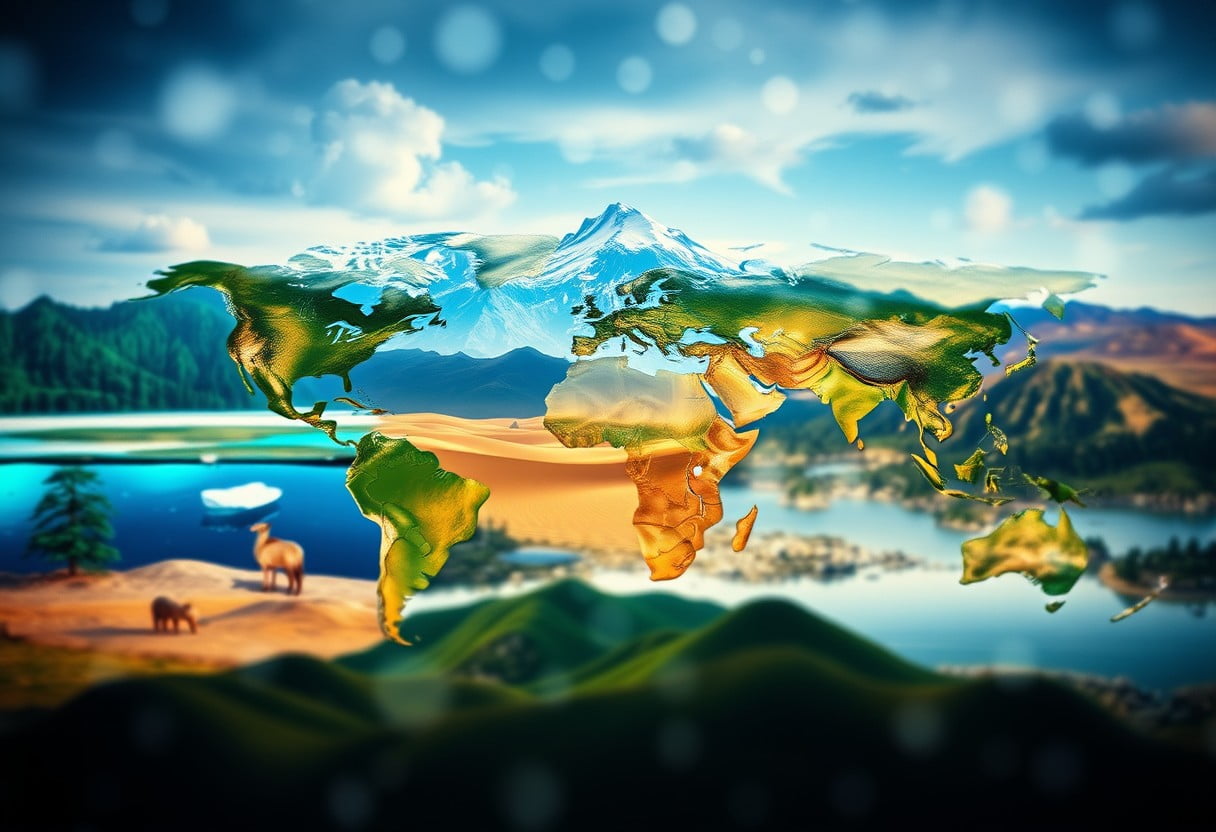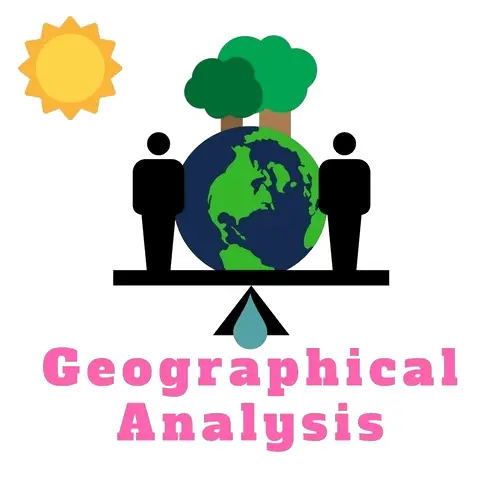Just imagine begining on a thrilling journey across the globe, uncovering the unique wonders that each of the seven continents has to offer. You will traverse through breathtaking landscapes, from the icy fjords of Antarctica to the lush rainforests of South America, while discovering diverse cultures and civilizations. This blog post invites you to explore the remarkable geographies and serene vistas that define our planet, showcasing the incredible beauty that awaits in every corner of the world. Buckle up for an enlightening adventure that promises to broaden your horizons and ignite your wanderlust.
Key Takeaways:
- Diversity of Landscapes: Each continent offers a unique blend of breathtaking landscapes, from the icy terrains of Antarctica to the deserts of Africa.
- Cultural Richness: A journey through the continents reveals a tapestry of cultures, traditions, and histories that enrich the travel experience.
- Ecological Variety: Exploring the seven continents showcases a vast array of ecosystems, highlighting the importance of biodiversity and conservation efforts.
- Adventure and Exploration: Traveling through diverse geographies provides numerous opportunities for adventure, whether through hiking, wildlife safaris, or exploring urban landscapes.
- Serenity and Reflection: Many natural wonders across the continents offer peaceful environments perfect for reflection, rejuvenation, and a deeper connection to nature.
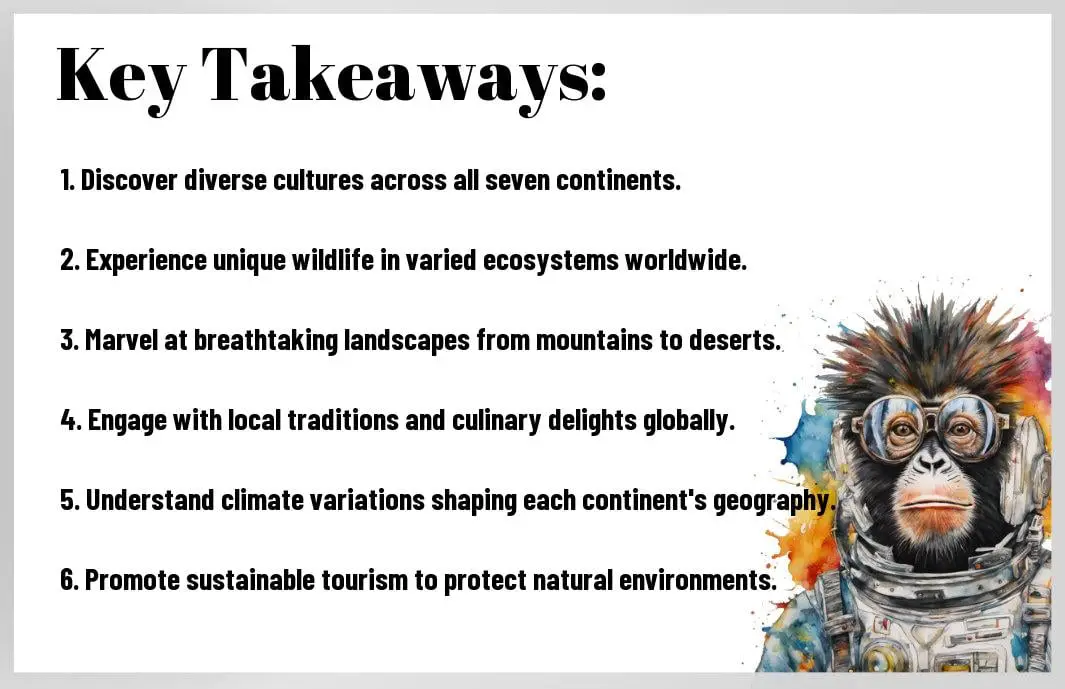
Overview of the Seven Continents
For anyone with a thirst for adventure, understanding the seven continents is the first step toward appreciating the vast array of cultures, landscapes, and ecosystems our planet has to offer. These continents—Africa, Antarctica, Asia, Europe, North America, Australia, and South America—were formed through various geological processes and have evolved over millions of years, reflecting the rich tapestry of Earth’s history. Each continent features its own unique characteristics, from the arid deserts of Africa to the icy expanses of Antarctica, highlighting the astonishing diversity of nature and human civilization.
Definition and Classification
For a clearer understanding, the classification of continents is primarily based on geographical boundaries, cultural distinctions, and historical significance. Traditionally, you recognize seven continents, although some models may only list six by combining Europe and Asia into a single landmass known as Eurasia. The separation of continents serves as a framework for studying Earth’s processes, climatic variations, and the way human societies adapt to their environments.
Classification can also differ based on geological criteria, such as tectonic plate boundaries, making it important for you to be aware of the various definitions adopted in different fields, including geography, geology, and cultural studies. Regardless of the classification you encounter, the fundamental idea remains the same: continents are vast landmasses that play a crucial role in defining the physical and cultural geography of your world.
Historical Significance
Significance lies in the fact that the seven continents are not just mere geographical entities; they are intricate narratives of human history. Each continent has been a stage for pivotal events that have shaped civilizations, driven migrations, and influenced socio-economic development. For instance, ancient empires flourished in Asia, while Europe became the cradle of the Renaissance—each area possessing its own unique stories and contributions to human progress.
Many of the world’s most critical developments—such as the agricultural revolutions, industrial advances, and the evolution of social and political structures—occurred in these distinct geographical settings. You will find that understanding these historical contexts not only enriches your travel experiences but also provides deeper insights into the interconnectedness of global cultures. Each continent tells a story, and as you endeavor to explore them, you partake in an ongoing narrative that resonates across time and space.
North America
The landscape of North America is a tapestry woven from diverse ecosystems and rich cultural heritage, making it a continent brimming with opportunities for exploration and adventure. From the rugged peaks of the Rocky Mountains to the lush forests of the Pacific Northwest, North America offers a plethora of breathtaking scenes. Its varied geography boasts everything from vast deserts to winding rivers and stunning coastlines. To gain more insight into the captivating visuals that embellish this continent, you might find interest in the Landscapes of the Seven Continents.
Diverse Ecosystems
An exploration of North America’s ecosystems reveals an astonishing variety of habitats that house a multitude of flora and fauna. From the sun-drenched deserts of the Southwest, where cacti thrive, to the sprawling wetlands of the Everglades, you will appreciate the natural diversity. The continent is also home to incredible forests that span from North to Central America; the diverse climates enable you to engage with wildlife ranging from majestic grizzly bears to colorful tropical birds. Each region adapts beautifully to its surroundings, presenting a unique spectacle of nature.
Alongside well-known national parks, such as Yellowstone and Banff, lesser-known sanctuaries like the coastal marshlands and temperate rainforests offer a rich experience for nature enthusiasts. In these ecosystems, you can immerse yourself in the natural world while discovering extensive trails perfect for hiking, bird watching, and photography. Whether you are seeking mountainous terrains or golden beaches, each location enhances your understanding of North America’s unparalleled biodiversity.
Cultural Heritage and Landmarks
For many, North America embodies a rich cultural tapestry that reflects its storied past. You will find ancient indigenous sites, colonial cities, and modern skyscrapers coexisting within vibrant communities. Historical landmarks, such as the Statue of Liberty in New York City and the ruins of ancient Pueblo dwellings in the Southwest, tell the tales of diverse peoples whose legacies continue to influence contemporary society.
Cultural influences permeate everything from culinary traditions to music, evident in cities such as New Orleans, known for its vibrant jazz scene and creole cuisine. While exploring, you will also encounter various festivals that celebrate this rich heritage, offering you an engaging glimpse into the lives of those who shaped the continent. The coexistence of different cultures creates a dynamic cultural landscape, inviting you to learn and embrace all that it encompasses.
Natural Wonders and Parks
An necessary aspect of North America’s allure lies in its natural wonders and parks. From the majestic Niagara Falls to the iconic Grand Canyon, the continent offers some of the most awe-inspiring sights on the planet. You can participate in various outdoor activities, from rock climbing in Yosemite National Park to kayaking in the pristine waters of Glacier Bay, enriching your travel experience with adventure and exploration.
This incredible diversity in natural beauty does not only enhance your travel itinerary but also evokes a profound appreciation for the environment. National parks and protected areas are semi-sacred havens where you can disconnect from everyday life and reconnect with nature. As you explore trails, engage in wildlife observation, or simply relax amidst stunning landscapes, you’ll realize that North America’s natural wonders are not just destinations, but experiences that deepen your understanding of the world around you.
South America
Many travelers dream of immersing themselves in the vibrant cultures and stunning landscapes of South America. This continent is a land of contrasts, offering everything from lush rainforests and imposing mountains to sprawling deserts and bustling cities. As you venture into the heart of South America, you will discover the unique ecosystems and rich history that set this continent apart from others.
The Amazon Rainforest
Amazon is the largest tropical rainforest on the planet, covering vast portions of Brazil, Peru, Colombia, and several other nations. It houses an unparalleled diversity of flora and fauna, many of which are found nowhere else in the world. As you explore this mesmerizing ecosystem, you may encounter exotic species like jaguars, macaws, and countless insects, along with towering trees that form a breathtaking canopy overhead. The Amazon River, the lifeblood of the rainforest, meanders through this landscape, supporting local communities and providing a vital source of water.
Adventuring through the Amazon’s dense vegetation, you’ll be struck by the sense of serenity that envelops you. The symphony of sounds from the wildlife, combined with the vibrant colors of the plants, creates an immersive experience that’s hard to forget. Whether you’re hiking through the jungle, taking a guided canoe trip, or engaging with local indigenous groups, the Amazon rainforest offers an unforgettable connection to nature and humanity.
The Andes Mountain Range
An awe-inspiring natural landmark, the Andes Mountain Range stretches over 4,300 miles along the western edge of South America, passing through seven countries. You will be captivated by the rugged beauty of the peaks, many of which reach heights over 20,000 feet. As you journey through this majestic mountain range, you will have the opportunity to explore breathtaking landscapes, including lush valleys, high-altitude lakes, and glaciers. The diverse climate and elevations result in an array of ecosystems that you can experience firsthand.
The Andes not only serve as a magnificent backdrop to your adventures but also play a crucial role in shaping the cultures and livelihoods of the people living in their shadows. The ancient Inca civilization thrived in this rugged terrain, leaving behind iconic archaeological sites like Machu Picchu, which you may wish to visit as you explore into the rich history of the region. The high-altitude farming and unique adaptations of flora and fauna further showcase the resilience and beauty of life in the Andes.
Cultural Influences and Indigenous Peoples
Influences from various indigenous groups and colonial histories blend to create a rich cultural tapestry across South America. When you explore cities such as Cusco or La Paz, you’ll notice how the vibrant traditions of the Andean peoples are intertwined with European influences, from architecture to cuisine. Local markets brim with handcrafted textiles, pottery, and jewelry that reflect the artistry of indigenous communities. You have the chance to witness colorful festivals that celebrate both ancient traditions and contemporary customs, allowing you to engage deeply with the local culture.
This fascinating cultural mélange extends to the music, dance, and culinary practices throughout the continent. As you savor local dishes that incorporate traditional ingredients, you will appreciate the enduring legacy of indigenous knowledge in agriculture and cooking techniques. Your journey will not only introduce you to the stunning landscapes of South America but also offer insight into the vibrant, living cultures that thrive within them.
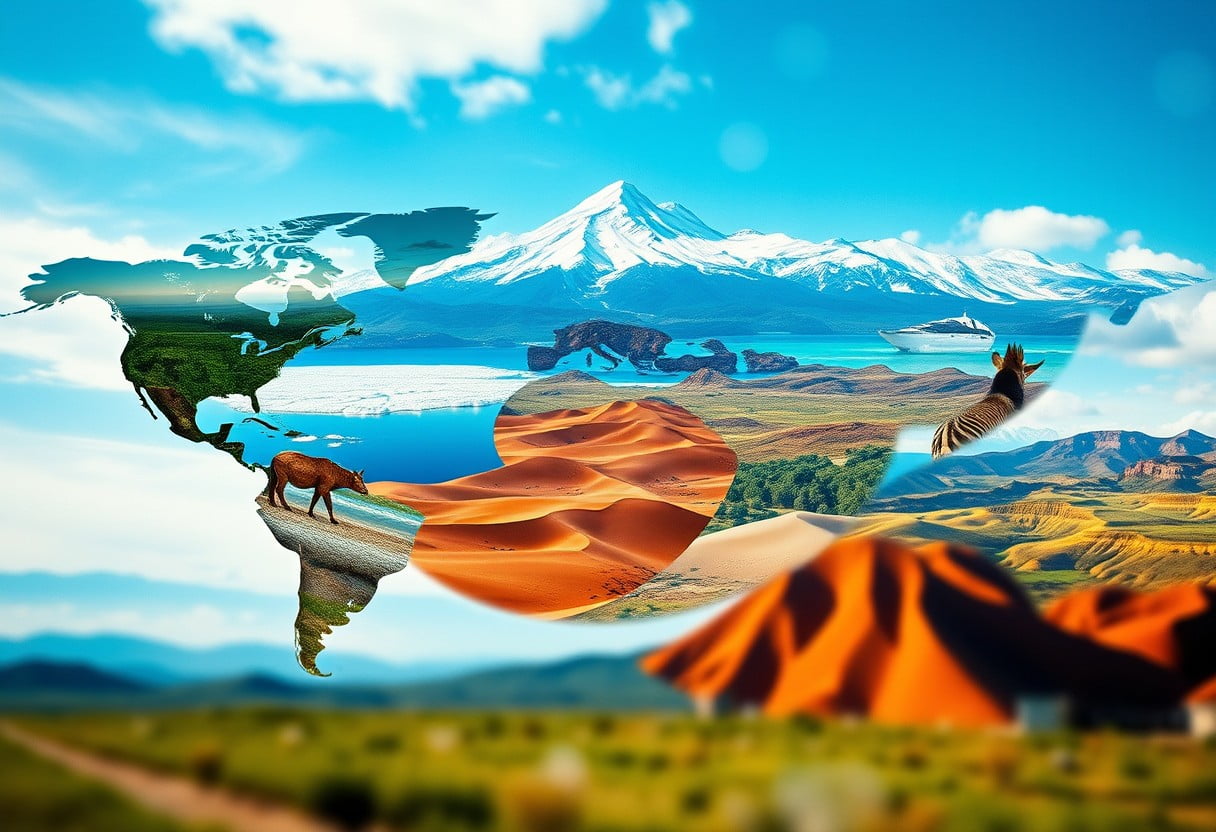
Europe
To begin on a journey through Europe is to explore a tapestry woven with vibrant cultures, stunning landscapes, and rich histories. Each country offers a unique narrative and contributes to the continent’s diversity. From the snowy peaks of the Alps to the serene coastlines of the Mediterranean, Europe presents a variety of geographies that can mesmerize any traveler.
Geographical Diversity
For those seeking an array of landscapes, Europe delivers in abundance. You can traverse through the lush valleys of the Rhine or immerse yourself in the rolling hills of Tuscany, each location presenting a different aspect of natural beauty. Northern Europe greets you with its rugged coastlines and breathtaking fjords, while the southern regions celebrate the warmth of the sun through picturesque beaches and crystal-clear waters. The central plains, with their fertile lands, are ideal for agriculture, showcasing that Europe is not only diverse in its scenic views but also in its ecosystem.
For adventure seekers, the continent also boasts a range of terrains suitable for skiing, hiking, and cycling. The majestic Dolomites provide an alpine playground, while the charming paths of the Camino de Santiago offer spiritual discovery as you walk through stunning landscapes. The geographical diversity of Europe ensures that there is something for every type of traveler.
Historical Sites and Architecture
The rich tapestry of history found in Europe is perhaps one of its most alluring features. You cannot help but be drawn to the ancient ruins of Rome, witness the grandeur of the Gothic cathedrals in France, or admire the ornate palaces that represent the opulence of European monarchies. These historical sites are not just remnants of the past; they are living testimonies of your ancestors’ narratives, inviting you to explore stories captured in stone and art.
Diversity is beautifully displayed through Europe’s architecture, where each region tells its own story through design. From the intricate details of Moorish architecture in Spain to the classical styles found in Greece, you will find influences from different cultures that have shaped the European continent over centuries. The iconic landmarks like the Eiffel Tower or the Colosseum stand out as symbols of human creativity and ingenuity, making every visit a journey through time.
Modern Cultural Landscapes
Modern Europe is a vibrant blend of tradition and innovation waiting for you to discover. As you roam through cities like Berlin, London, or Barcelona, you will encounter a fusion of contemporary art, music, and culinary experiences that celebrate diversity while honoring the past. The thriving street art scenes, pop-up galleries, and the bustling café culture reflect a dynamic society where different influences coexist harmoniously.
Modern cultural landscapes are continuously evolving, showcasing urban development alongside historic preservation. As you explore deeper into different cities, you will find that modern architecture often meets ancient structures, creating a dialogue between past and present. This unique juxtaposition adds to the allure of Europe, reminding you that while progress shapes today’s cities, history remains an integral part of their identity.
To truly experience Europe’s cultural richness, you must engage with its locals, immerse yourself in its festivals, and savor its culinary delights. By doing so, you not only explore diverse landscapes but also forge connections that transcend geographical boundaries.
Asia
Not only is Asia the largest continent in the world, but it is also a melting pot of cultures, landscapes, and histories. This vast landmass stretches from the icy tundras of Siberia in the north to the tropical rainforests of Southeast Asia. Every nook and cranny offers something different, providing you with a unique opportunity to explore extraordinarily diverse geographies and serene landscapes.
The Vast Terrain and Varied Climates
With an expanse that covers over 44.58 million square kilometers, Asia boasts a stunning array of terrains ranging from towering mountain ranges to endless plains. You can traverse the expansive deserts of the Middle East, indulge in the lush greenery of Southeast Asia, or stand in awe of the majestic Himalayas that protect the awe-inspiring beauty of Bhutan and Nepal. This diversity is mirrored in the continent’s climates, which oscillate between the humid subtropical conditions of southern regions to the frigid aridity of northern areas. Such climatic variations not only shape the geography but also influence your travel experiences as you discover the different flora and fauna that thrive in these environments.
Major Rivers and Mountains
Terrain plays a critical role in defining Asia’s distinctiveness, particularly highlighted by its remarkable rivers and mountains. The continent is home to some of the world’s longest rivers, including the Yangtze and the Mekong, which provide you with avenues for exploration—be it through river cruises or adventurous kayaking trips. Mountains like the iconic Mount Fuji in Japan and the Karakoram Range in Pakistan serve as iconic geographic markers that showcase nature’s power and beauty. These features offer spectacular views and unparalleled hiking experiences for the adventure enthusiast in you.
It is in these rivers and mountains that you can truly appreciate the sheer beauty of Asia. The Ganges River, revered as sacred by millions, flows through India, inviting you to witness its mesmerizing rituals and landscapes along its banks. Meanwhile, the Tianshan Mountains in Central Asia stand as a stunning backdrop to rich historical sites, urging you to explore the age-old Silk Road and the stories etched in stone. Each of these natural wonders opens doors to unforgettable experiences, encouraging you to explore deeper into the heart of Asia.
Cultural Richness and Heritage
On your journey through Asia, you will encounter not only diverse landscapes but also a tapestry of cultures that have flourished for thousands of years. This continent is home to myriad ethnic groups, languages, and traditions, each contributing to a rich cultural heritage that is both complex and captivating. From the ancient practices of Tibetan Buddhism to the serene rituals of Hinduism in Bali, you can marvel at the depth and variety of beliefs and lifestyles that illuminate everyday life in this region.
Varied historical monuments dot the landscape, reminding you of Asia’s storied past. Iconic structures such as the Great Wall of China and the Taj Mahal in India stand as tributes to architectural brilliance, while local festivals such as Diwali in India and Lunar New Year across several Asian countries showcase the vibrancy of contemporary culture. Through food, art, and local customs, you are invited to engage deeply with the nuances that define what it means to be Asian, enriching your understanding of the world’s largest continent.
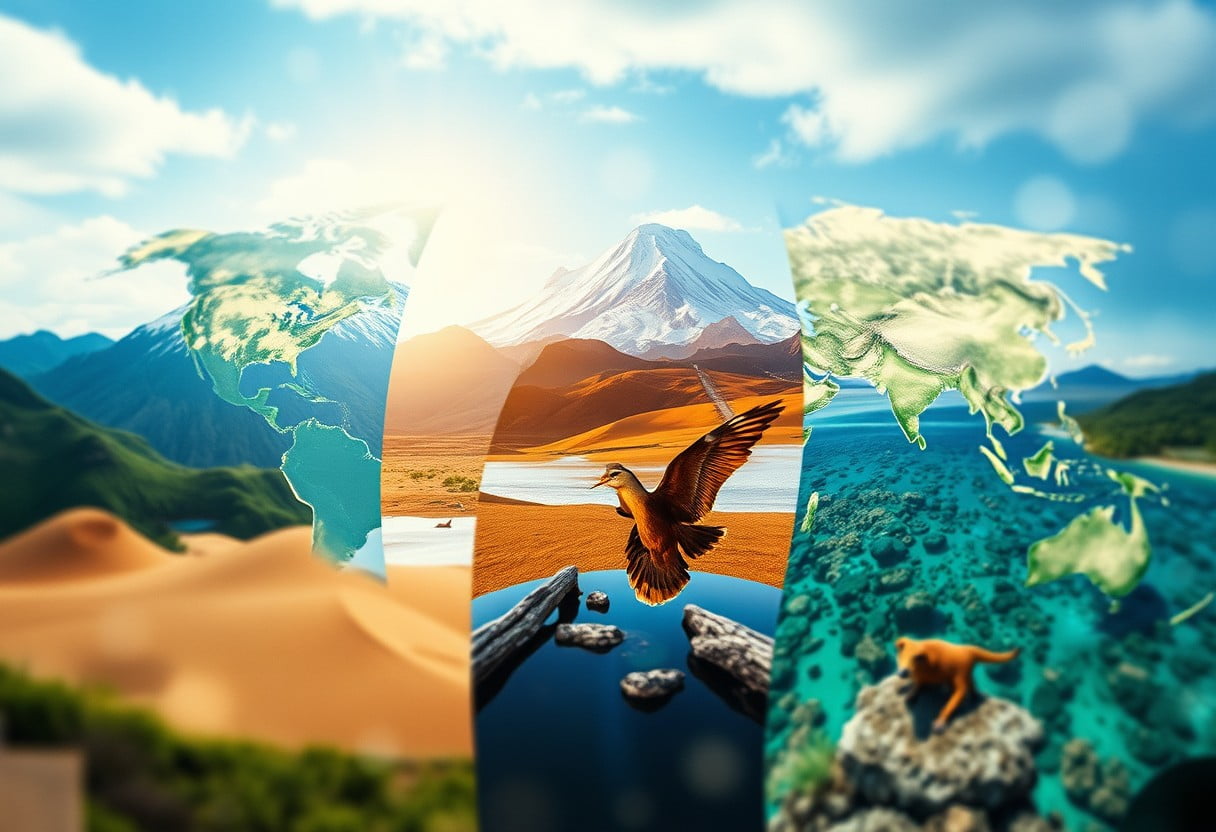
Africa
Unlike any other continent, Africa stands as a testament to nature’s raw beauty and complexity. It is a land of striking diversity, from the arid expanse of the Sahara Desert to the lush, vibrant rainforests of the Congo. The geography varies dramatically; you can find expansive savannas filled with wildlife, soaring mountains, and serene coastlines where the Atlantic and Indian Oceans meet. Each region boasts its unique identity, culture, and ecosystem, inviting you to launch on an adventure unlike any other.
Unique Biomes and Wildlife
The different biomes of Africa create a habitat for some of the most extraordinary wildlife on Earth. As you journey through its landscapes, you’ll encounter the majestic elephant roaming the savanna, the elusive leopard resting in the trees, and flocks of colorful birds singing throughout the day. The Great Rift Valley houses unique geological formations and is home to a variety of animal species, while the wetlands of Okavango Delta thrive with an array of biodiversity. You will quickly realize that Africa’s wildlife is not just about the famed “Big Five”—the lion, leopard, rhinoceros, elephant, and Cape buffalo—but also includes countless other unique creatures that contribute to the complexity of its ecosystems.
The distinct climatic zones affect the flora and fauna directly, meaning your experience will vary as you traverse the continent. In arid regions, you may discover resilient flora adapted to thrive in harsh conditions, while tropical settings offer an entirely different assortment of plant life and animal interactions. Understanding these unique biomes is crucial for appreciating the continent’s role in the world’s ecological balance.
Ancient Civilizations and Modern Societies
Societies in Africa have evolved from ancient times, shaping the rich tapestry of the continent you see today. The ancient Egyptians, known for their incredible architectural feats, left behind a legacy of knowledge, mythology, and art that captivates millions every year. As you research into history, you’ll uncover the kingdoms of Kush, Mali, and Great Zimbabwe, each contributing to the cultural ethos and societal structures that exist presently. The influence of trade routes, exchanges of ideas, and migrations have forged a complex narrative that still defines the identities of modern African nations.
Modern developments have juxtaposed the deep-rooted traditions of African cultures with the influences of globalization and technology. From bustling cities like Johannesburg and Nairobi to rural communities, you can experience a blend of old and new, where festivals honoring ancient heritage coexist with modern innovations and lifestyles. Understanding these dynamics will allow you to appreciate the resilience and adaptability of African societies in the current global landscape.
Conservation Efforts and Challenges
Challenges in conservation efforts across Africa are as diverse as its landscapes. Rapid urbanization, poaching, and climate change threaten the delicate ecosystems that harbor some of the world’s rarest species. As you learn about these pressing issues, it becomes clear that maintaining a balance between development and environmental protection is a vital endeavor. Communities are often caught in a struggle to utilize their resources sustainably while also seeking economic growth.
Proactive conservation strategies are being implemented across the continent, focusing on protecting wildlife habitats and raising awareness about the importance of biodiversity. Numerous organizations and grassroots movements work tirelessly to combat illegal poaching and promote sustainable tourism practices that benefit both the environment and local communities. Another significant stride toward conservation includes efforts to restore and reconnect fragmented habitats, allowing wildlife corridors that facilitate migration and genetic diversity. By engaging with these conservation initiatives, you can contribute to sustaining Africa’s rich heritage and ensuring its incredible biodiversity continues to thrive for generations to come.
Australia and Oceania
All who venture into the breathtaking landscapes of Australia and Oceania are treated to a unique tapestry of nature and culture. This region is characterized by its stunning array of environments, from the sunburned outback and vibrant coral reefs to the picturesque islands dotted across the Pacific Ocean. Your journey through Australia and Oceania will be enriched by the knowledge of its distinct geographical features, offering a deeper understanding of the intertwined relationship between nature and the indigenous cultures that have thrived here for thousands of years.
Distinct Flora and Fauna
Australia is renowned for its distinctive flora and fauna, some of which can be found nowhere else on the planet. The continent boasts a plethora of unique species, such as the kangaroo, koala, and emu, showcasing the evolutionary pathways that have emerged due to its isolation. You might find yourself captivated by the vast arrays of eucalyptus trees that dominate the landscape, each hosting diverse wildlife adapted to its singular environment. In addition to its mammals, Australia’s marine life is equally impressive, with the Great Barrier Reef serving as a testament to the rich biodiversity that resides beneath the waves.
This extraordinary biodiversity is complemented by Oceania’s myriad islands, where you’ll encounter lush rainforests, active volcanoes, and coral atolls. Each island has its own specific ecosystem, containing unique terrestrial and marine life. Whether you are snorkeling through the clear waters of Fiji or exploring the diverse plant life of New Zealand, you will feel a profound connection to these ecosystems and an appreciation for the intricate balance of life that sustains both flora and fauna.
Indigenous Culture and Traditions
Oceania is home to a wealth of indigenous cultures that have cultivated rich traditions over millennia. The Maori people of New Zealand, for example, have a strong connection to their land and a unique worldview expressed through art, dance, and storytelling. You will find that elements of these cultures are deeply woven into the fabric of daily life, from traditional tattoos to communal gatherings that celebrate their heritage. Festivals like the Pasifika Festival in Auckland allow you to immerse yourself in the vibrant cultures of the Pacific Islands, promoting a sense of unity and respect for ancestral traditions.
The indigenous peoples of Australia, including the Aboriginal and Torres Strait Islander communities, have navigated this rugged land for tens of thousands of years. They possess an intimate understanding of nature, seen in their Dreamtime stories and cultural practices that emphasize a deep respect for the environment. When you engage with these communities, your appreciation of their oral histories and sacred connection to the landscape will undoubtedly deepen, enriching your experience in this diverse region.
Island Nations and Ecosystem Diversity
The beauty of Australia and Oceania extends beyond its landmass to encompass the countless island nations scattered throughout the Pacific Ocean. Each island nation, including Fiji, Samoa, and Tonga, boasts its own unique ecosystems, showcasing rich biodiversity and distinct cultural practices. As you explore these islands, you will be amazed by the variety of habitats, from volcanic mountains to serene lagoons, each supporting a myriad of wildlife and plant life adapted to their specific environment.
With the diversity of ecosystems comes remarkable opportunities for exploration and conservation. The Pacific Islands serve as critical habitats for numerous endangered species, and protecting these fragile ecosystems becomes paramount to maintaining global biodiversity. As you traverse this enchanting region, you will gain a greater understanding of the importance of coral reefs, rainforests, and coastal wetlands, and the role they play in supporting both local communities and the health of our planet.
Ecosystem diversity in Australia and Oceania is not only a source of natural beauty but is also vital for the survival of various plant and animal species. By visiting and learning about these environments, you contribute to a global movement advocating for conservation and sustainable practices. Your own journey through these dynamic landscapes will shed light on the interdependent relationships between organisms and the environments they inhabit, reinforcing the notion that every effort counts in preserving these ecological treasures for future generations.
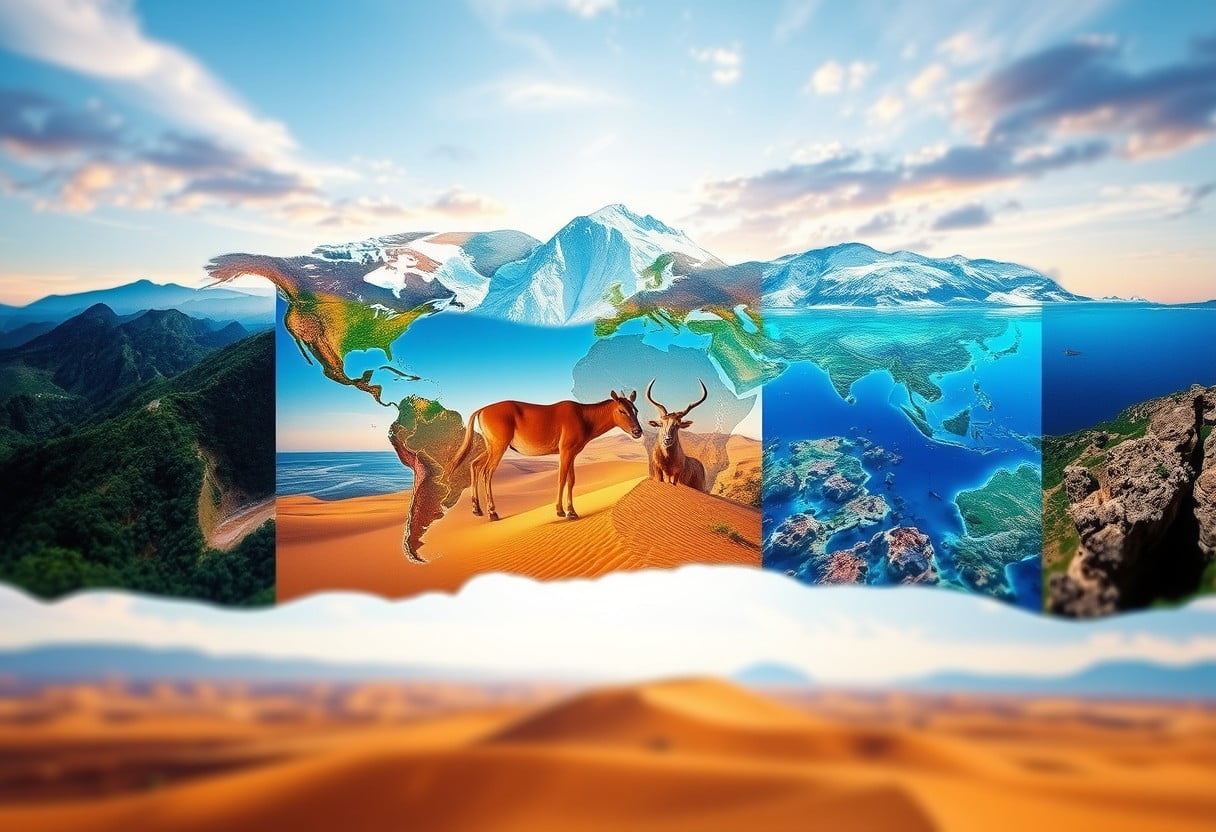
Antarctica
Despite its reputation as a barren, icy wasteland, Antarctica is a continent rich in geological features and climate extremes that capture the imagination. It is home to vast ice sheets, towering glaciers, and rugged mountain ranges that provide insights into the Earth’s geological history. You may be fascinated to discover that beneath its icy surface lies a complex tapestry of ancient rock formations, often shaped by tectonic activity and glaciation processes. The climate here is one of the most severe on Earth, characterized by frigid winds, plummeting temperatures, and minimal precipitation, creating an environment that is as inhospitable as it is intriguing.
Geological Features and Climate
Any visitor, whether virtual or real, cannot help but be struck by the stark beauty of Antarctica’s landscapes. The continent is nearly covered by ice, which contains around 60% of the freshwater on the planet. When you explore its intricacies through photos or documentaries, you’ll find expansive ice shelves, such as the Ross Ice Shelf, as well as the towering peaks of the Transantarctic Mountains. The conditions here have led to the formation of unique geological structures, including subglacial lakes that remain liquid despite the crushing cold above due to geothermal heat.
As for the climate, it is characterized by stark extremes that vary widely across seasons and locations. The interior can reach temperatures as low as -80°F (-62°C), while coastal areas are somewhat milder. The continent also experiences 24 hours of sunlight during summer and extended darkness during winter, leading to unique seasonal habitats that support limited but fascinating life forms. Understanding these extreme conditions can deepen your appreciation for the resilience required for survival in such a harsh environment.
Research Stations and Human Impact
With the growing interest in climate change and environmental studies, numerous countries have established research stations across Antarctica to study its unique ecology and geology. These stations serve as hubs for scientific research, facilitating your understanding of the region’s climate patterns, marine biology, and glaciology. Each of these installations houses a small population of scientists and support staff who conduct experiments, gather data, and contribute to our ever-expanding knowledge of this remote continent.
A deep examination of human activity reveals both positive and negative impacts on the Antarctic environment. While research stations promote scientific advancements crucial for understanding global climate change, they also present challenges like pollution, waste management, and habitat disruption. You might find it concerning that increased human presence can lead to unintended consequences, such as the introduction of non-native species which threaten local biodiversity.
Biodiversity in Harsh Environments
On the other hand, Antarctica also showcases a fascinating, albeit fragile, ecosystem that has adapted to survive in extreme conditions. You might be interested to learn that despite its harsh climate, the continent provides a unique habitat for a variety of organisms, including penguins, seals, and an array of seabirds. The surrounding Southern Ocean is teeming with life, from krill to whales, all of which play critical roles in the marine food web and contribute to the biodiversity that sustains this remote region.
Impact of climate change poses a serious threat to the biodiversity found in this unspoiled wilderness. Rising temperatures and melting ice are creating shifts in habitats that can endanger species reliant on ice-covered regions for breeding and foraging. The pressure of human activity, including fishing and tourism, amplifies these effects, potentially disrupting the delicate balance that has allowed life to flourish in such an inhospitable place. Understanding these dynamics is crucial for preserving the unique biodiversity and fragile ecosystems of Antarctica.
Conclusion
Hence, as you traverse the enchanting landscapes and diverse geographies of the seven continents, you cultivate a deeper appreciation for the world’s rich tapestry of cultures, ecosystems, and histories. Each continent offers a unique narrative that shapes its identity, from the towering peaks of the Himalayas in Asia to the vibrant rainforests of South America. This journey not only broadens your understanding of global diversity but also deepens your connection to the environment and the humanity that inhabits it. By embracing the multitude of experiences each continent has to offer, you can enhance your worldview and enrich your life’s journey.
Your exploration of these varied terrains enables you to witness firsthand the fragile beauty of our planet, encouraging a sense of responsibility in preserving these natural wonders. As you navigate through this multifaceted world, remember that each destination leaves an imprint, reinforcing your role as a global citizen. Therefore, let your adventures inspire you to advocate for sustainable tourism practices that ensure future generations can also enjoy the breathtaking landscapes and vibrant cultures across the continents. In essence, your journey is not just about discovery but also about stewardship—a chance to make a positive impact as you explore the magnificent threads that weave the fabric of our world.

